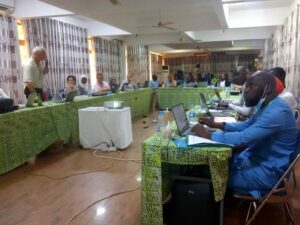CSIR-SARI introduces ultimate wetting and drying irrigation for improved rice yield
 The Council for Scientific and Industrial Research-Savanna Agricultural Research Institute (CSIR-SARI) has introduced a new irrigation farming method to maximise water use and improve rice yield.
The Council for Scientific and Industrial Research-Savanna Agricultural Research Institute (CSIR-SARI) has introduced a new irrigation farming method to maximise water use and improve rice yield.
Referred to as the ultimate wetting and drying method, the technique was introduced to rice farmers at the Tono irrigation scheme in the Upper East Region as part of the Wagrinnova project.
It involves the use of soil water monitoring tools for irrigation scheduling decisions such as the chameleon sensor and wetting front detector, introduced by the Commonwealth Scientific and Industrial Research Organisation (CSIRO) and monitored by the Virtual Irrigation Academy (VIA).
Mr Ramson Adombilla, an Irrigation Engineer at CSIR-SARI, who spoke about the irrigation method, said the Wagrinnova project looked at sustainable rice intensification, having several principles to contribute to water productivity and crop yield.
He was speaking at the end of the Wagrinnova project meeting in Tamale organised by the CSIR-SARI and the University for Development Studies (UDS).
The meeting was attended by various project implementing partners to showcase work done over the years and to learn from one another.
The Wagrinnova project is a consortium, consisting of different agencies, including UDS and CSIR-SARI in Ghana and other countries like Senegal and Burkina Faso to demonstrate to farmers the efficient use of water. It was funded by the LEAP-Agri and European Union.
Mr Adombilla said the ultimate wetting and drying method would help farmers to monitor water levels as and when the water level fell within their rice fields to inform decisions of when to irrigate to curb instances of farmers continuously flooding their farms.
He said, “Aside from this method, we also introduced simple tools that are user-friendly for farmers to use to inform their irrigation scheduling, being able to tell when and how much water to apply to a crop.”
He noted that “These tools use colours in the form of lights to communicate the soil moisture levels to the farmers, whether the soil is falling short of moisture or has moisture.”
Wagrinnova project saw many activities during its implementation, including a gender study to ascertain if women were involved in irrigation decision-making and irrigation scheduling practices.
Dr Edward Martey, the Coordinator of the Wagrinnova project at CSIR-SARI, said during the study, it was found that there were strict gender roles in the northern part of the country, adding that the study gave an idea of entry points to reduce some of the strict gender roles.
He said the team would follow up in the project implementation areas to find out if remedies to include women in the Agro-ecology decision-making were effective.
He stated that the project duration was three years but CSIR-SARI carried out its implementation within a year hence needed to come together to learn from other implementation partners and share experiences.
He said, “We are not all at the same level of implementation. Others have gone far ahead of us but currently, there is harvesting going on and we will put data together, analyse our report and send to the donors.”
Dr Cheickh Sadibou Fall, an Economist and Foresight Officer at the Institutè Sénégalais de Recherches Agricole (ISRA), who presented the Senegalese result on the project, said each African country within the project tried to work with a European country to share advantages and technologies from each side to help local producers.
He said the organisation used a down-top approach to assess challenges farmers were facing in optimising rice production in the implementation regions of Senegal.
Source: GNA
